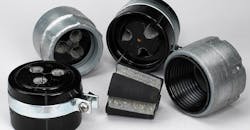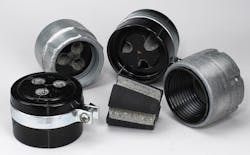When constructing the Empire State Building in 1930, engineers found that the heavy non-armored electrical cable installed in vertical raceways or risers imposed excessive strain on terminations, panels, or other connected devices. In all, electricians installed a staggering 2,500,000 feet of electrical wire to convey the 40,000,000 kilowatt hours used by the building and its tenants annually. To answer this challenge of how to safely install vertical conduit raceways in a 102-story building, the engineers relied on cast iron and hardwood cable supports. This year, as the Empire State Building celebrates the 89th anniversary of its groundbreaking — amazingly, many of those same cable supports remain in service.
Cable supports are one of the electrical industry’s unsung heroes. Designed specifically to support cables in vertical raceways and eliminate strain on terminations, the supports can make the difference between being connected or disconnected in multi-story buildings. When installed, they provide end-users with enhanced safety and lower maintenance.
Cable supports must provide needed support to the heavy cable without damaging the insulation or excessively reducing the amount of insulation over time, so the materials that are used and their engineering are important. Impregnated hardwood or synthetic thermoset plastic wedging plugs and resin are standards. Phenolic/laminate bodies, combined with sealing compound, are also used for certain applications, since they can furnish a weatherproof seal and provide ventilation at the top of the conduit riser. Proper venting can reduce the temperature in a riser by up to 20°F.
Types of Cable Supports
Cable support design is deceptively simple: Essentially, bushings go over the opening of the conduit in which non-armored cables pass through. Since the shape of the bushing is like a wedge, the weight of the wires tightens the bushing around them. The wedge exerts uniform pressure around the cable, providing holding force of that required by code without deforming the cable insulation.
There are two basic types of cable supports: the one-piece plug and the multiple segment plug. The one-piece has a single wedging plug with a groove for each wire. It is ideal for all types of non-armored cables 600V or less, plus it is considered the easiest to install. In contrast, the multiple segment version has a wedging plug constructed so that each cable is supported between grooves in adjacent segments. This uniform pressure distribution is required by the softer types of insulations frequently used at higher voltages. Some supports line cable grooves with coarse grain grit to improve holding power. This grit won’t damage the jacket or insulation on the cable. In both cases, either single or multiple segment, it is good practice to space conduits about ½ in. or further than normal to accommodate the cable support body.
Getting a Grip on the Code
The National Electrical Code (NEC) calls out specific installation methods for long vertical runs of conductor. Section 300.19 of the NEC states that cable support is needed at the top of a long raceway, with intermediate supports installed at specified lengths per a formula based on the size of the wire, some as frequently as every 35 feet. NEC Table 300.19(A) provides the distances required between supports for the conductors (see Table).
Let’s look at an example. In a 10-story building with conduit runs from the basement to the top floor with raceway containing 4/0 copper conductors, the unsupported copper cable length cannot exceed 80 feet. The heavier the wire, the shorter the unsupported cable length. Per the NEC, the only exception is as follows:
“Steel wire armor cable shall be supported at the top of the riser with a cable support that clamps the steel wire armor. A safety device shall be permitted at the lower end of the riser to hold the cable in the event there is slippage of the cable in the wire-armored cable support. Additional wedge-type supports shall be permitted to relieve the strain on the equipment terminals caused by expansion of the cable under load.”
The NEC also lists these four ways to support cable [Sec. 300.19(C)].
• “By clamping devices constructed of or employing insulating wedges inserted in the ends of the raceways. Where clamping of insulation does not adequately support the cable, the conductor also shall be clamped.
• “By inserting boxes at the required intervals in which insulating supports are installed and secured in an approved manner to withstand the weight of the conductors attached thereto, the boxes being provided with covers.
• “In junction boxes, by deflecting the cables not less than 90° and carrying them horizontally to a distance not less than twice the diameter of the cable, the cables being carried on two or more insulating supports and additionally secured thereto by tie wires if desired. Where this method is used, cables shall be supported at intervals not greater than 20% of those mentioned in the preceding tabulation.
• “By other approved means.”
There is a misconception that the NEC doesn’t come into play on low-voltage installations. However, there is no exemption for voltage. The requirements in Sec. 300.19 apply to all installations — high or low voltage. The requirement is to support each cable, not rely on the cables themselves to support other cables.
Self-Support Cable
In runs shorter than 100 feet, cable can be self-supporting based on the tensile strength of the cable and the weight of the cable spool/box. Self-supporting cable has a high-tensile-strength fiber cord in addition to the wire pairs, which makes the cable “self-supporting” for a certain free-hanging distance. The tensile strength of the cable and the weight of the cable spool/box are typically available from the cable manufacturer. That said, any type of resistance to pulling the cable adds to its breaking force (i.e., pulling it from a reel that has a brake shoe or from a pull box where the cable snags in the box opening and the box is lifted along with the cable). In addition, pulling up through vertical conduit adds its own forces because the cable is binding on the conduit walls.
For example, say the maximum breaking pull strength of a low-voltage cable is 50 pounds, and a 1,000-foot spool of it weighs the same. Ideally, you could hang the entire length in midair in an open duct supporting it from one end without worries that it could break. Now, if a member of the maintenance crew gives a pull to the cable from the bottom for whatever reason, this may exceed the cable’s tensile strength — leading the cable to snap near the top and come tumbling down, thus creating a dangerous situation. Pulling up on vertical conduit results in the cable binding on the conduit walls. Plus, there is the hanging dead weight of the cable itself, again leading to potential breakage.
Specifying Cable Supports
When ordering a cable support, manufacturers ask the purchaser that they specify the number of conductors being supported and to provide each conductor’s outside diameter (OD), in addition to the conduit trade size, voltage, and dry or wet location. Slight variations in cable OD can render a support plug either too large or too small. Jacket sizes can fluctuate — so can stranded wire depending on things like the number of strands, amount of twist, and manufacturing processes. For this reason, it is recommended that the person doing the ordering (purchaser, project manager, or lead electrician) use a digital micrometer or calipers to accurately measure the cable’s OD.
Another problem that occurs in the field is when an electrician, pressed for time to complete a job, upsizes the cable being installed to one that is available on-site, rather than waiting for the right-sized cable to be delivered. The factory-drilled supports are now too small for the cable. Ordering and installing only the cable support body prior to wire pulling can alleviate the problem. The other part of the support — the wedging plug — can be ordered later.
Vertical runs of “no-lube” cables introduce another wrinkle, one that requires a bit of knowledge of coefficients of friction. Here is the problem: No-lube jackets are slippery. Because of this, a wedging plug featuring grooves lined with a coarse grain grit is recommended. This grit improves the cable support holding power and does not damage the jacket or insulation on the cable.
Retrofit Applications
When electricians hear the word “retrofit,” they assume they’re replacing an existing worn part for a new one. However, in the context of cable supports, “retrofit” refers to specialized supports that are installed after conductors are pulled and terminated, not before. The support isn’t being replaced, since it wasn’t there in the first place.
What situation would call for a retrofit cable support? Let’s look at the example of an inspector or authority having jurisdiction conducting a final inspection of a high-rise who finds a Code violation involving the vertical raceways, specifically the lack of cable support. This type of problem happens on job sites, as every experienced electrician knows.
Since the split body of a retrofit-style support rests on an existing bushing atop the conduit raceway, it is possible to use it where cables are already installed. The two halves of the body are placed around the cables, seated on the existing bushing, and securely held together by the steel band set in a groove around the body. The plug is then wedged between the cables, and the job is done.
Final Thoughts
Unfortunately, there is no shortage of confusion when it comes to cable support requirements. With so much at stake, it’s the electrician’s responsibility to fully understand Sec. 300.19 compliance and best industry practices as well as the difference in cable support types.
Cunningham is a product marketing manager for Electrical & Lighting solutions at Emerson Automation Solutions in Rosemont, Ill. He has six years’ experience as an NECA/IBEW electrician. Contact him at [email protected].
About the Author
Frank Cunningham
Product Marketing Manager for Electrical & Lighting Solutions
Frank Cunningham is a senior product marketing manager with Emerson’s Appleton Lighting team. He helps develop new industrial LED lighting solutions by applying more than 16 years of electrical industry experience in technical support and inside sales roles along with field experience as a journeyman electrician. He is based at the Appleton headquarters in Rosemont, Ill.



